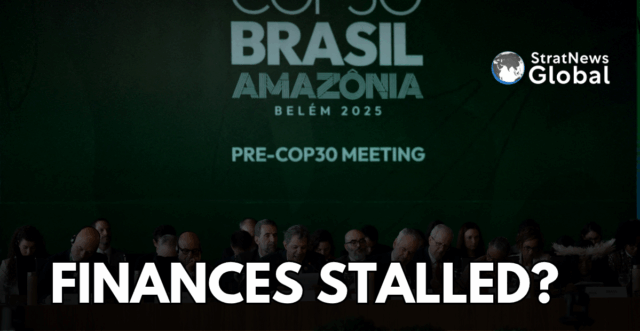India’s Environment Minister Bhupender Yadav said on Monday evening at COP30 that India will submit its revised Nationally Determined Contributions (NDCs) for 2035 by December. These national pledges, central to the Paris Agreement, spell out how each country plans to cut emissions and adapt to climate impacts.
Inside the negotiation halls in Belém, delegates described an increasingly tense atmosphere. This year’s COP has seen an unprecedented presence of fossil-fuel lobbyists. Earth.Org reported that the coalition Kick Big Polluters Out estimates more than 1,600 lobbyists are attending, meaning “one in every 25 attendees represents coal, oil or gas interests.” Their footprint exceeds that of many national delegations.
For climate-vulnerable countries and civil society groups, this is more than symbolic. They argue that corporations linked to the climate crisis have been allowed deep access to the process while key decision-makers remain absent. Activists say the imbalance underscores a larger concern: CO₂ levels continue to reach new highs while the money required to confront escalating impacts remains at the heart of the debate.
At COP29 in Baku, countries set two headline finance numbers: a post-2025 collective finance floor of USD 300 billion per year by 2035, and an aspirational USD 1.3 trillion per year under the “Baku to Belém” roadmap. Global South negotiators, including India, viewed even these figures as insufficient. A new Lowy Institute analysis suggests that the process may fall short of securing these levels at COP30. The United States has reduced climate-related foreign aid, and several European donors have also begun cutting back. The United Nations has warned of a USD 310-billion gap in adaptation finance.
Srinivas Krishnaswamy, CEO of the Vasudha Foundation, told StratNewsGlobal last week, “There continues to be a lot of unresolved issues at the Belem cop! Notably is the one related to Article 9.1 of the Paris Agreement that requires developed countries to provide financial resources to developing countries for both adaptation and mitigation. Developing countries are also pushing for 1.3 trillion of climate finance annually by 2035.”
Even agreement on who provides the money would not resolve the next sticking point: how it will be distributed. Krishnaswamy noted, “Whether it is project-based, like the Green Climate Fund or any new innovative model or based on GDP, that needs to be seen.”
Climate experts say they do not expect a full resolution at this summit. While some initiatives have shown signs of movement, many gaps persist.
For India, Yadav reiterated at COP30 that developed countries must reach net zero far earlier than their current target dates. He added that they must also deliver “new, additional and concessional finance” at a scale of trillions. The measure of progress in Belém, he said, will ultimately depend on whether countries can secure money that matches the level of ambition.
With 2035 deadlines approaching and global emissions still above safe limits, Brazil’s COP30 presidency faces the task of restoring confidence in a process struggling to keep pace with a warming world.





